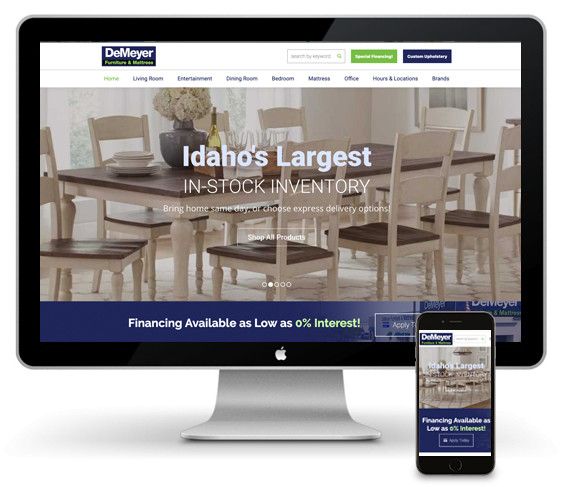Choosing the right e-commerce website platform for your new online store can be a “make or break” for some people, so it’s best to do your thorough research far before you jump in and start building a website. This will avoid the potential heartache down the road should you find out that you need to switch platforms.
In this article, we’re going to focus on the top 4 e-commerce platforms used today, in 2021.

1. WooCommerce
(Cost: Free (Open-Source), Additional Cost for Needed Plugins)
WooCommerce is WordPress’s e-commerce platform. By definition, WooCommerce is a massive plugin that seamlessly integrates within WordPress, but calling it a “plugin” wouldn’t be entirely accurate due to how big it is. Think of WordPress as a “sister” platform that controls everything you’d ever need to sell online.
Setting up WooCommerce
As far as WooCommerce goes, it’s not the easiest e-commerce platform to use for novices. It definitely requires the most knowledge of WordPress, customizations that range from getting taxes, payments, discount codes and overall layout and appearances just right.
In fact, WooCommerce was never designed to be the easiest, but instead the most intuitive for developers and/or clients that need something that’s far more advanced than just an easy shopping cart.
WooCommerce Add-Ons & Plugins
There are hundreds of plugins for WooCommerce available to purchase. The good news, is that most of these are either a one-time purchase, or a very low annual cost. The exception to the rule would be 3rd party plugins such as inventory software, or other similar ones. We recently built a website for a client using QuickBooks online, and the annual renewal is $150-$200/yr for the QuickBooks sync extension, so they can get costly depending on the need for functionality.
Design and Layout Options
WordPress websites using WooCommerce have specific layouts for product categories, search result pages, and checkout, all dependent on the design theme being used. However, like other platforms, you can definitely change the layout and appearance of a WooCommerce website with a little knowledge of HTML, CSS, and basic changes by just changing the theme settings.
Pros:
– Very Customizable – Both for small and large e-commerce websites and functionality needs
– Low Cost – No monthly or annual cost for WooCommerce, but only certain plugins if needed
– Widely Used – WordPress/WooCommerce is a very popular platform, so finding add-ons and solutions is usually easy due to the amount of plugins available
– Developer-Friendly – If you’re a web developer, or hire one, he/she will find that WooCommerce provides lots of access to backend code without hacking through a field of unknowns.
– Open Source – This means that you own the website, and you can host it anywhere you’d like to.
Cons:
– Not the easiest platform for beginners looking for a quick solution and fast store
– Although free, sometimes plug-ins needed to assist with add-ons such as shipping automation, labels, payment processing, can all cost more money
– Updates need to be done manually, or at least monitored. Updates made to WooCommerce can be automated, but all open-source software can be a little more risky, compared to those that are controlled by the company.

2. Shopify

Shopify has emerged as an e-commerce leader over the past 10 years. In fact, due to advertising, Shopify is easily one of the top 3 most popular e-commerce platforms available. Many enjoy Shopify’s user interface, as it’s much easier to use for the beginner, compared to a platform such as WooCommerce, for example.
Setting things up are a breeze, and you definitely don’t need to identify as a web developer to feel fairly confident navigating around the backend, although some may find that it takes a bit of getting used to remembering where everything is located, etc.
Shopify is a subscription-based platform, so all updates to the platform are done for you, which means you don’t ever need to worry about plugins or themes going out of date.
Designing and Developing with Shopify
Shopify has a fairly large library of design options to choose from when getting started. By default, you will choose a design theme to build your website on. From there, you’ll use the theme settings that are built in to customize the look and feel of your website. For example, Shopify has a page builder for the home page that includes you adding a slideshow, category images and links, text and images, social media icons and much more.
If you identify as a web developer and need to take things to the next level, you’ll find that working with Shopify’s page templates on the backend are a bit more of a chore compared to WooCommerce. Shopify themes are built using a language called “Liquid” that was developed by the founders. If you’re familiar with PHP, you’ll get to learn Liquid after awhile, and see some similarities (and many differences), just like comparing any other programming language.
Add-Ons and Functionality
Shopify does a few things really well. This includes integrating payment, shipping and taxes with a few clicks. However, where they fall flat, is when any new functionality is needed, there’s apps that are either purchased, or if you’re lucky, you can find a free version. We’ve worked with clients before using Shopify, where they had so many add-ons, that their monthly cost went from $30/mo to $150/mo. We refer to this as being “app-ed” to death, all in fun of course, but not fun for your wallet. 🙂
Pros:
– Fairly easy for the novice or beginner – Most everything you need is built in, making Shopify one of the most popular platforms for beginners.
– Easy to configure payments, taxes and shipping – Shopify makes these crucial steps easy to dial in
– Tons of design themes to choose from – For most, they’ll find plenty to choose from without the need to do too much advanced development or theme modifications.
– Automated updates – Because you’re playing for a subscription-based service, changes and improvements to the platform are all made automatically.
Cons:
– Not open-source – This means that you cannot simply move your website anywhere. If you ever choose to have a new website built off of Shopify, you’ll end up having to rebuild the whole thing on the new platform.
– Apps cost a lot – If your store needs any advanced functionality or add-ons, apps will add up fast, which means you’ll be spending more every month.
– Backend theme design/modifications aren’t super easy – Unless you’re comfortable swimming in code, you’ll find that modifying theme files in Shopify is best saved for a professional.

3. ECWID
(Cost: Free up to $99/month depending on plan)
ECWID has blown up as an e-commerce solution for both professionals and beginners. ECWID stands for “E-commerce widget,” as their entire framework is marketed as a drag and drop solution. This means that you can easily install ECWID into any existing website. This includes WordPress, Squarespace, Wix, Weebly, Joomla, Custom HTML/PHP websites and more.
ECWID has been a fantastic solution for many of our clients who don’t need the complexity of a larger store, and/or where budget makes sense for a simpler solution.
ECWID has such a great user-interface, and is arguable easier to use than even Shopify. Although ECWID has their own store templates (minimal amount to choose from), it is generally used within an existing website’s design.
WordPress and ECWID Integration
One thing that’s been a really great feature of ECWID, is that they offer a WordPress plugin that seamlessly integrates within a website. This means that you can basically manage everything ECWID-related inside of WordPress.
ECWID allows for lots of easy customization, and they even have a feature which will automatically read a website’s design by pulling in the CSS styles. This automatically matches the product page buttons, checkouts and fonts to match with the rest of the website, while still allowing the user to edit the CSS of ECWID if necessary as well.
ECWID is great in the fact that they also make setting up payments, taxes, shipping, discount codes a breeze, all without charging the user any extra money.
Pros:
– Extremely easy to use – Very easy to sign up for an count and install on any website
– Automatically adjusts colors and styles to match the current website’s design
– No extra charges for standard functionality – This includes payment setup, automated shipping options via FedEx, UPS, and USPS, as well as taxes and shipping codes.
– Very affordable – pricing options starting at free, and slowly increasing based on amount of products needed and functionality
– Drag and drop for all website platforms – This makes ECWID an obvious choice for many older websites who may not want a redesign but need a quick solution.
Cons:
– Not open source – This means that you cannot move the cart anywhere, and you’re at the mercy of ECWID, including if they ever go out of business or get bought out.
We’ve built many e-commerce websites using all 3 platforms above, so we’re confident in providing you with real-life experience based on the websites our clients have needed over the years to achieve their online stores.
For more information on our shopping cart choices, check out our e-commerce solutions and how Thrive can help build your online store!







